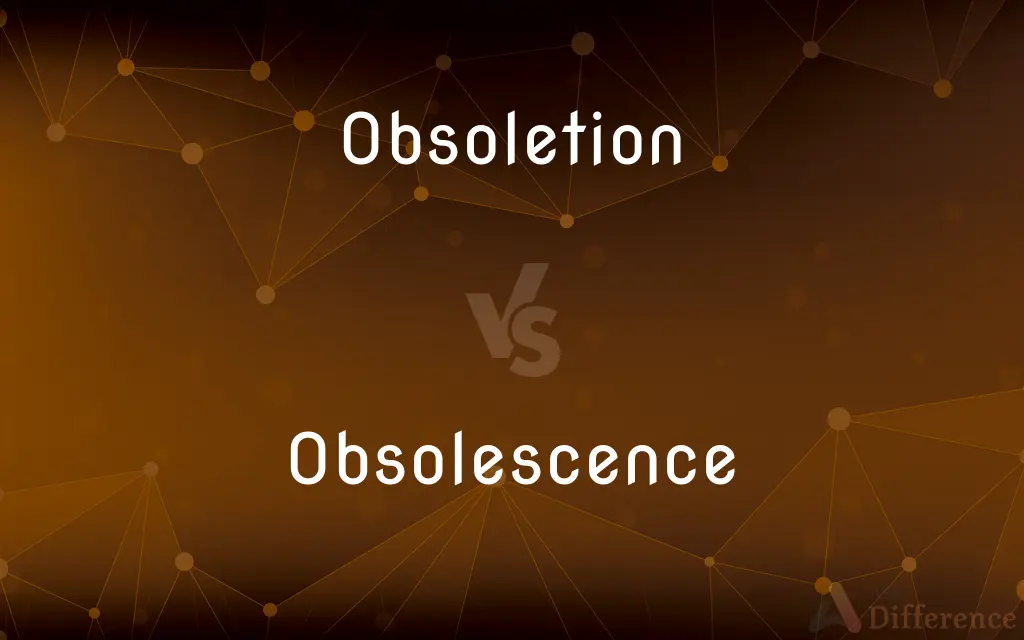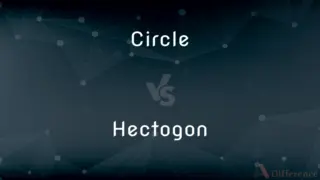Obsoletion vs. Obsolescence — What's the Difference?
By Tayyaba Rehman & Fiza Rafique — Updated on March 27, 2024
Obsoletion is the process of becoming outdated or no longer used, while obsolescence describes the state of being outdated or superseded.

Difference Between Obsoletion and Obsolescence
Table of Contents
ADVERTISEMENT
Key Differences
Obsoletion refers to the act or process of becoming obsolete or out of use, typically because a newer, more efficient, or more effective option has emerged. It signifies the journey towards becoming irrelevant. On the other hand, obsolescence is the condition of being obsolete. It represents the outcome of the obsoletion process, where a product, service, or concept no longer holds value or relevance in the current context.
While obsoletion emphasizes the transition or phasing out of usefulness, obsolescence highlights the end state of that process. For instance, the obsoletion of floppy disks began as more efficient storage solutions were developed, leading to their obsolescence, where they are now considered an outdated form of data storage.
The concept of obsoletion is dynamic and ongoing, focusing on the process that leads to a decrease in utility and relevance. In contrast, obsolescence is static, describing a condition that has already been achieved. This distinction is important in industries that rapidly evolve, such as technology and fashion.
Planned obsoletion is a strategy where products are designed to become obsolete within a specific timeframe, encouraging consumers to purchase newer models. This contrasts with natural obsolescence, which occurs without intentional planning, often as a result of technological advancements or changes in consumer preferences.
Understanding the difference between obsoletion and obsolescence is crucial for businesses and consumers alike, as it affects decision-making regarding product development, purchases, and the lifecycle management of goods and services.
ADVERTISEMENT
Comparison Chart
Definition
The process of becoming obsolete or no longer used.
The state of being obsolete or no longer used.
Focus
Process and transition towards becoming outdated.
End state or condition of being outdated.
Nature
Dynamic and ongoing.
Static and final.
Examples
The phasing out of VHS tapes as DVDs became popular.
The widespread irrelevance of VHS tapes today.
Relevance to Innovation
Indicates ongoing need for updates and upgrades.
Highlights areas where innovation has already occurred.
Compare with Definitions
Obsoletion
Transitioning from standard to outdated due to technological advancements.
The obsoletion of traditional landlines is evident with the popularity of smartphones.
Obsolescence
The condition of being outdated or no longer used.
The obsolescence of floppy disks is clear as they are no longer compatible with modern computers.
Obsoletion
The gradual decline in popularity or usage of a product or concept.
The obsoletion of physical maps has been noticeable since the advent of GPS technology.
Obsolescence
A state where something no longer serves its original purpose efficiently.
The obsolescence of dial-up internet connections became apparent with the spread of broadband.
Obsoletion
The act of phasing out or discontinuing use due to new alternatives.
The obsoletion of typewriters accelerated with the rise of personal computers.
Obsolescence
Being superseded by newer, more efficient alternatives.
The obsolescence of incandescent bulbs is advancing in favor of LED lighting.
Obsoletion
A process where something becomes less effective over time.
The obsoletion of old software versions happens as new updates are released.
Obsolescence
The result of technological or stylistic advancements rendering something less desirable.
The obsolescence of flip phones was inevitable with the introduction of smartphones.
Obsoletion
The movement towards irrelevance in a particular context or environment.
The obsoletion of fax machines in offices has been underway due to email and digital document sharing.
Obsolescence
A condition that indicates a need for replacement or upgrade.
The obsolescence of an old operating system necessitates an upgrade to maintain software compatibility.
Obsoletion
Obsolescence.
Obsolescence
Obsolescence is the state of being which occurs when an object, service, or practice is no longer maintained, required, or degraded even though it may still be in good working order.The international standard IEC 62402:2019 Obsolescence Management defines obsolescence as the "transition from available to unavailable from the manufacturer in accordance with the original specification".Obsolescence frequently occurs because a replacement has become available that has, in sum, more advantages compared to the disadvantages incurred by maintaining or repairing the original. Obsolete also refers to something that is already disused or discarded, or antiquated.
Obsolescence
Being in the process of passing out of use or usefulness; becoming obsolete.
Obsolescence
(Biology) Becoming reduced during the course of evolution; vestigial or nearly vestigial. Used of an organ or other part of an organism.
Obsolescence
(uncountable) The state of being obsolete—no longer in use; gone into disuse; disused or neglected.
Obsolescence
(countable) The process of becoming obsolete, outmoded or out of date.
Obsolescence
The state of becoming obsolete.
Obsolescence
The process of becoming obsolete; falling into disuse or becoming out of date;
A policy of planned obsolescence
Common Curiosities
What causes obsoletion?
Obsoletion is typically caused by technological advancements, innovation, or changes in consumer preferences that make existing products or processes less effective or desirable.
Is planned obsolescence ethical?
The ethics of planned obsolescence is debated; critics argue it leads to wasteful consumption, while proponents believe it drives technological progress and economic growth.
Can obsolescence be reversed?
While obsolescence itself is a static condition, efforts such as refurbishing, updating, or repurposing can make an obsolete product relevant again in certain contexts.
How does obsolescence affect consumers?
Obsolescence often forces consumers to purchase new products or find alternative solutions, which can lead to increased costs and consumption.
Can obsolescence benefit the environment?
Not typically; obsolescence usually results in waste unless mitigated by recycling or repurposing efforts.
How does planned obsoletion affect product life cycles?
Planned obsoletion shortens product life cycles by design, encouraging more frequent purchases.
Can obsolescence lead to economic growth?
Yes, obsolescence can stimulate economic growth by creating demand for new products and technologies.
What is technological obsolescence?
Technological obsolescence occurs when a product or process becomes outdated due to newer technology.
How do companies manage obsoletion?
Companies manage obsoletion through innovation, by continuously developing and updating products to stay relevant and meet evolving consumer needs.
How do trends influence obsolescence?
Trends, especially in fashion and technology, can accelerate obsoletion by shifting consumer preferences toward newer products.
What is the difference between obsoletion and depreciation?
Obsoletion refers to losing relevance or usefulness, whereas depreciation is an accounting term that represents the decrease in an asset's value over time.
What industries are most affected by obsoletion?
Technology, electronics, and fashion are among the industries most rapidly affected by obsoletion due to fast-paced changes and trends.
What role does innovation play in obsoletion?
Innovation is a key driver of obsoletion, as new developments make older methods or products less relevant or efficient.
How does obsoletion impact cultural practices?
Obsoletion can alter cultural practices by phasing out traditional methods or tools in favor of modern alternatives.
How can consumers deal with rapid obsolescence?
Consumers can deal with rapid obsolescence by opting for modular or upgradable products, supporting sustainable brands, or choosing products with longer life spans.
Share Your Discovery

Previous Comparison
Circle vs. Hectogon
Next Comparison
Behavior vs. BehavioralAuthor Spotlight
Written by
Tayyaba RehmanTayyaba Rehman is a distinguished writer, currently serving as a primary contributor to askdifference.com. As a researcher in semantics and etymology, Tayyaba's passion for the complexity of languages and their distinctions has found a perfect home on the platform. Tayyaba delves into the intricacies of language, distinguishing between commonly confused words and phrases, thereby providing clarity for readers worldwide.
Co-written by
Fiza RafiqueFiza Rafique is a skilled content writer at AskDifference.com, where she meticulously refines and enhances written pieces. Drawing from her vast editorial expertise, Fiza ensures clarity, accuracy, and precision in every article. Passionate about language, she continually seeks to elevate the quality of content for readers worldwide.
















































